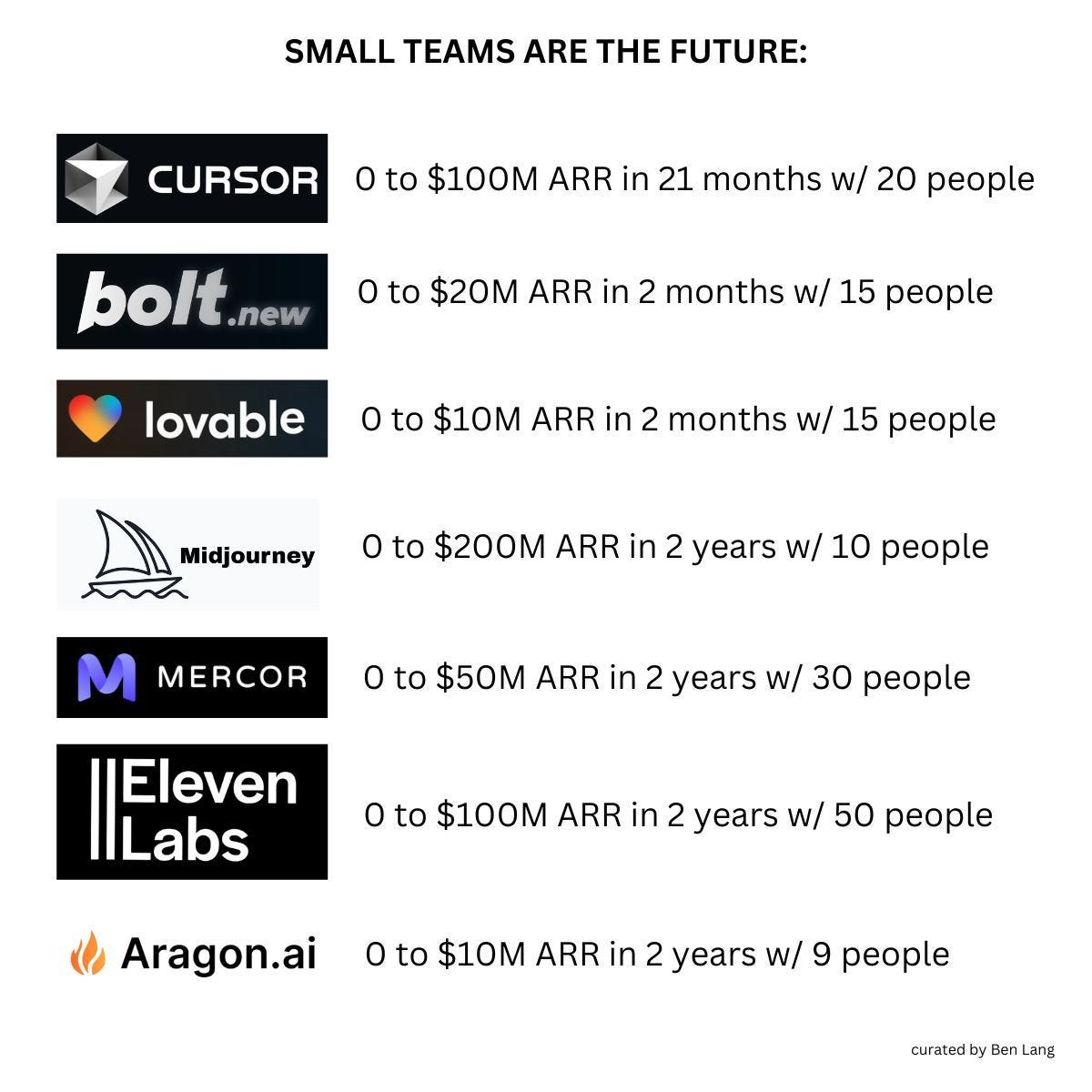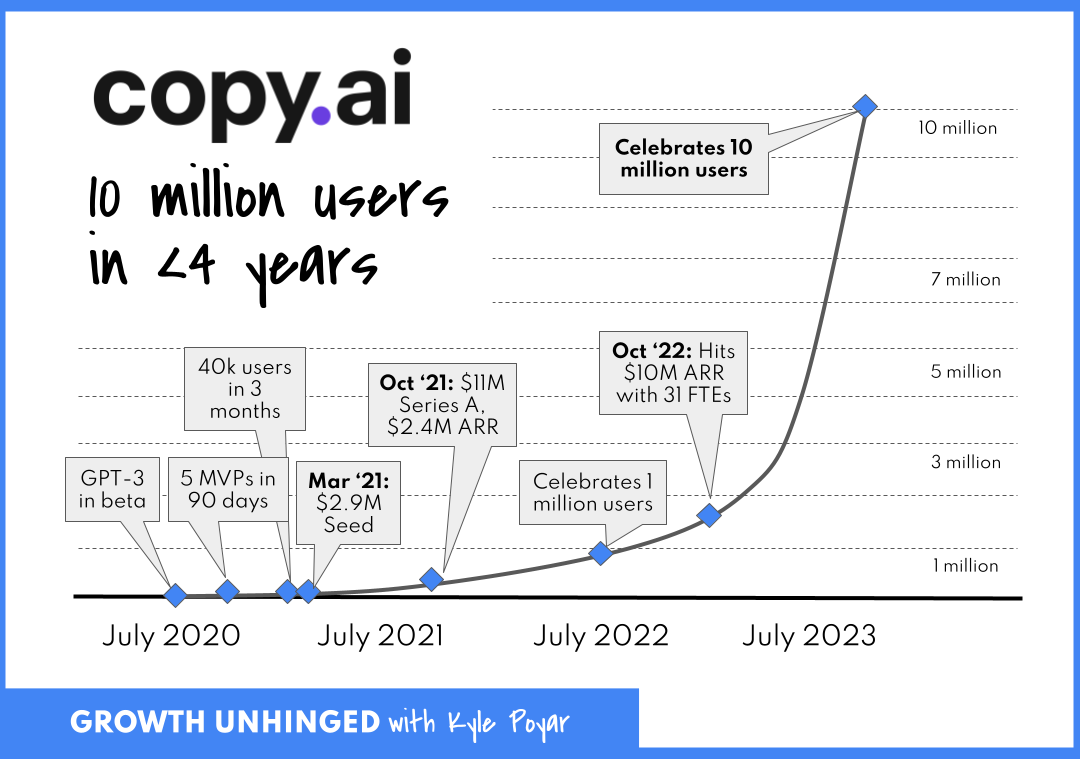How Deep Wrappers Are Dominating GenAI 🔪
A historical look at winning in GenAI
Having tried my hands at some AI startups, I am starting to see some patterns. When OpenAI dropped the GPT-3.5 Turbo API in 2023, it wasn’t just a technical milestone but a beginning. Startups raced to stake their claim in the GenAI gold rush, splitting into two camps: deep tech visionaries crafting bespoke models, and wrapper companies building atop existing frameworks. By March 2025, the scoreboard tells an unexpected tale.
These aren’t your average wrappers. They’re deep wrappers—companies like Cursor, Bolt, Lovable, and Mercor that master speed, UX, and network effects to deliver exceptional value. My thesis? Startups should embrace this deep wrapper playbook until they hit $10 million in revenue, using that milestone to pivot toward proprietary models if needed. In GenAI’s chaotic early days, this phased approach isn’t just smart—it’s the best way to grow faster.
Speed Beats Invention
Back in 2020, Copy.ai launched with GPT-3, hitting 10 million users by 2024—one of the earliest deep wrappers to prove the model. Jasper followed, turning content creation into a juggernaut and showing wrappers could scale big. Fast forward to 2023: Cursor emerged with an $8 million seed, soaring to $100 million ARR and a $2.6 billion valuation by December 2024. Bolt, from StackBlitz, hit $20 million ARR in two months by 2025, redefining app development. Lovable raised $22.5 million, reaching $17 million ARR in three months, making software engineering accessible. Mercor, though less detailed, hints at similar promise in AI-driven hiring.
Contrast this with deep tech. OpenAI’s $157 billion valuation and $17 billion raised by October 2024 are staggering, but the cost is steep. Anthropic’s $14.3 billion by March 2025 mirrors the same grind. Deep wrappers, meanwhile, sprint ahead, proving execution outpaces invention in GenAI’s wild west.
The Deep Wrapper Evolution
The journey from basic AI wrappers to deep wrappers is a tale of adaptation and obsession with user value. Early wrappers like Copy.ai and Jasper started simple—Copy.ai launched in 2020 with GPT-3, churning out taglines for $3/month to test demand, while Jasper’s initial content tools were mocked as glorified autocomplete. These pioneers leaned on raw API power, offering quick wins but little differentiation. Fast-forward to 2025, and deep wrappers like Cursor, Bolt, Lovable, and Mercor have rewritten the script. They didn’t just slap a UI on an LLM—they evolved into powerhouses by turning basic tools into indispensable platforms.
Take Cursor. It began as a forked VS Code editor with ChatGPT and Claude integrations—hardly revolutionary. But its evolution into a deep wrapper came through relentless focus on developers’ pain points. Real-time code suggestions with “why?” explanations built trust, while its chat for brainstorming mimicked a pair programmer. By 2024, shareable snippets and multi-file editing plans turned it into a community hub, hitting $100 million ARR in 12 months. Speed to market? Weeks, not years. UX? Intuitive and collaborative. Networks? Developers evangelized it, amplifying growth.
Bolt’s story is even faster. Born from StackBlitz, it launched as a browser-based playground for GPT-driven app creation. Early iterations were basic—type a prompt, get a scaffold. But Bolt deepened its wrapper status by 2025, adding natural language prompts that generate full-stack apps, instant deployment to Netlify, and shareable demos. No setup, no friction—just results. This UX polish slashed app-building time from days to minutes, driving $20 million ARR in two months. Its network effect kicked in as creators shared demos, pulling in more users. Speed was Bolt’s launchpad; UX and networks made it soar.
Lovable took a different tack, democratizing app development. Starting in 2023, it offered a barebones code generator. But its pivot to guided modes and templates—think “build a to-do app” with drag-and-drop ease—transformed it into a deep wrapper. By 2025, it hit $17 million ARR in three months, fueled by 25,000 daily builds. Speed came from skipping R&D for proprietary models; UX shone in its novice-friendly design; networks grew as creators swapped templates, creating a flywheel of adoption.
Mercor, though less documented, likely followed a similar arc in hiring. Early AI-driven resume screening evolved into a platform blending seamless UX—think one-click candidate matching—with community features like shared talent pools. Speed got it to market; UX kept recruiters hooked; networks could scale it via hiring manager buzz.
What separates deep wrappers from their thin ancestors? Evolution through user obsession. Early wrappers like Copy.ai proved demand but plateaued—Copy.ai took four years to hit 10 million users, a slog compared to Cursor’s sprint. Deep wrappers doubled down on execution: Cursor shipped features weekly, Bolt slashed development cycles, Lovable simplified complexity, and Mercor streamlined workflows. They layered custom UX atop APIs, turning “here’s AI” into “here’s your win.” Unlike deep tech’s slow burn—OpenAI took eight years and $17 billion to hit scale—deep wrappers hit escape velocity with less, proving agility trumps invention in GenAI’s early days.
Why Deep Wrappers Dominate
Deep wrappers don’t just ride APIs—they build moats no deep tech can match early: speed of execution, UX, and network effects. Here’s why these are the only defenses that stick.
Speed of Execution: First-Mover’s Edge
In GenAI, speed is survival. No R&D slog—just relentless shipping on existing models. “In new tech cycles, you’ve got a two-to-three-year head start,” notes Copy.ai’s Paul Yacoubian. Deep wrappers seize it; deep tech lags.UX: The Trust Anchor
“AI isn’t the differentiator—great UX is,” writes Yaakov Carno. Cursor’s real-time code explanations, Bolt’s natural language prompts, and Lovable’s guided templates prove it. A 2025 study of 767 users confirms: “Customers don’t care about AI features”—they want results like “code 50% faster.” Deep wrappers deliver clarity; deep tech’s black boxes falter.Network Effects: The Growth Flywheel
Wrappers compound growth. Cursor’s shareable snippets, Bolt’s deployable apps, and Lovable’s 25,000 daily builds turn users into evangelists. Mercor’s community-driven hiring could follow suit.
Only deep wrappers secure this trinity fast. Building models risks obsolescence—new LLMs drop constantly. Wrappers pivot, staying ahead.
How Users Perceive GenAI
The magic of deep wrappers is in how they crack the code on what users actually value. Forget the buzzwords: a 2025 study of 767 users reveals people don’t care about “AI-powered” labels—they crave tangible wins like time saved, friction erased, or goals nailed. Deep wrappers like Cursor, Bolt, Lovable, and Mercor don’t just build on APIs; they design and brand their products to mirror these desires, turning perception into their secret weapon. Understanding this shift is key to why they outpace deep tech and how you can follow suit.
Users see GenAI’s worth through three lenses: efficiency, simplicity, and outcomes. Cursor’s real-time code suggestions slash debugging hours—developers don’t marvel at the AI, they celebrate coding 55% faster. Bolt’s browser-based stack skips setup, letting creators spin up apps in minutes; the value isn’t the LLM, it’s the instant gratification. Lovable’s guided templates turn novices into app-builders overnight—25,000 daily builds aren’t about AI hype, they’re about empowerment. Even Mercor, likely streamlining hiring, wins by cutting recruiter busywork, not by flaunting algorithms. Efficiency, simplicity, outcomes: that’s the GenAI currency.
Deep wrappers align their design to this perception with surgical precision. Cursor doesn’t pitch “AI coding”—it’s a collaborator, explaining suggestions so users trust the process. Bolt skips “GenAI app builder” for a vibe: type a prompt, see an app, share it—frictionless creativity. Lovable brands as “software for everyone,” its templates a bridge to action, not a tech showcase. Mercor, we can infer, might frame itself as “hiring made human,” hiding AI behind seamless matches. This isn’t random—it’s a deliberate shift from early wrappers like Copy.ai, which sold “AI content” before pivoting to “faster workflows.” Users don’t buy AI; they buy what it does for them.
Branding follows suit, amplifying the moats. Speed shines in Bolt’s “instant apps” promise—$20 million ARR in two months proves it resonates. UX drives Cursor’s “your coding partner” ethos, building trust en route to $100 million ARR in 12 months. Network effects kick in as Lovable’s community swaps templates, branding it a creator hub, not just a tool. Perception isn’t static, though—deep wrappers evolve it. Cursor’s multi-file editing plans signal deeper workflows; Bolt’s deployable demos hint at collaboration. They listen, iterate, and reframe value as users’ needs shift.
How do you align your product? Design for the win users see: Cursor’s speed saves time, Lovable’s simplicity lowers barriers, Bolt’s outcomes deliver results. Strip “AI” from your branding—test “build faster” or “hire smarter” instead, like Mercor might. Lean on UX to make value obvious: previews, templates, explanations. Feed network effects with shareable outputs—think Bolt’s apps or Lovable’s builds—to turn users into advocates. Early wrappers like Jasper learned this the hard way, pivoting from tech flex to user wins. Deep wrappers get it from day one, designing and branding not for AI’s sake, but for the user’s triumph.
This alignment isn’t a nice-to-have—it’s the bridge from scrappy launch to lasting moat. Deep tech dazzles with models, but users shrug unless it solves their day. Deep wrappers, from Copy.ai’s pioneer days to Cursor’s modern sprint, show the playbook: meet users where they value you, and build from there.
The Deep Wrapper Playbook
The First $10 Million
Start as a deep wrapper, hit $10 million ARR, then decide. Why $10 million? Valuations hit $300–500 million, unlocking $50–100 million raises for models without stalling. Until then, deep tech’s risks—cost, obsolescence—are too high.
Phase 1: Blitz the Market
Launch fast—Cursor did it with VS Code, Bolt with a browser. Reinvest in UX and GTM. Lovable’s 25,000 daily builds show speed’s power.Phase 2: Lock In Value
Scale to $10 million ARR by refining what users love. Cursor’s $100 million in 12 months proves it. Bolt’s $20 million in two months doubles down.Phase 3: Pivot or Push
With cash, choose: deepen your wrapper or go deep tech. Cursor’s $2.6 billion valuation hints at what’s next.
Not into Deep Wrapper? Here’s how you can pivot:
From Wrapper to Deep Wrapper
Launch Lean, Iterate Fast: Cursor forked VS Code, scaling to $100 million ARR in 12 months. Bolt hit $20 million ARR in two with a browser stack. Use APIs, launch in weeks, target communities—developers, creators.
Sell Outcomes, Not AI: Cursor pitches “code 55% faster,” Bolt “apps in minutes.” A/B test “save 30 minutes” vs. “AI-powered.” Outcomes win.
Design UX for Trust: Cursor explains suggestions, Lovable offers templates. Test usability—simplify if users pause. Trust is your anchor.
Hack Networks: Bolt’s deployable apps, Cursor’s snippets spark virality. Incentivize sharing—Lovable’s 30,000 users grew via community.
Price for Stickiness: Bolt’s freemium, Cursor’s $49/month hook then upsell. Test weekly—find the prosumer sweet spot.
Loop Feedback: Lovable’s 25,000 builds refined UX; Cursor’s dual modes came from users. Use X posts, surveys—co-create with your base.
From Deep Tech to Deep Wrapper
Partner for Speed: Anthropic could launch a Bolt-style app with APIs, cutting GTM years. Redirect R&D to UX.
Launch a Sidecar: Deepgram could test a Cursor-esque tool in 30 days. Scale if it hits $5 million ARR.
Reframe Benefits: Pitch “never take notes” (Otter.ai), not “speech AI.” Test landing pages—results over tech.
Build Collaborative UX: Cursor’s “why?” feature, Bolt’s prompts guide users. Test for trust—preview changes, offer rollbacks.
Seed Networks: Target niches—data scientists, designers. Bolt’s shareable demos show how. Add integrations (Slack, GitHub).
Hybridize: Use wrapper revenue to fund R&D. Cursor might blend custom tech next. Transition via feature flags.
Deep Wrappers Will Dominate GenAI
Speed gets you in, UX keeps you there, networks make you untouchable. Deep tech can’t match this pace or virality early. Wrappers alone secure these moats fast, pivoting as AI shifts.
Agree or disagree? Let me know what you think in the comments ;)





